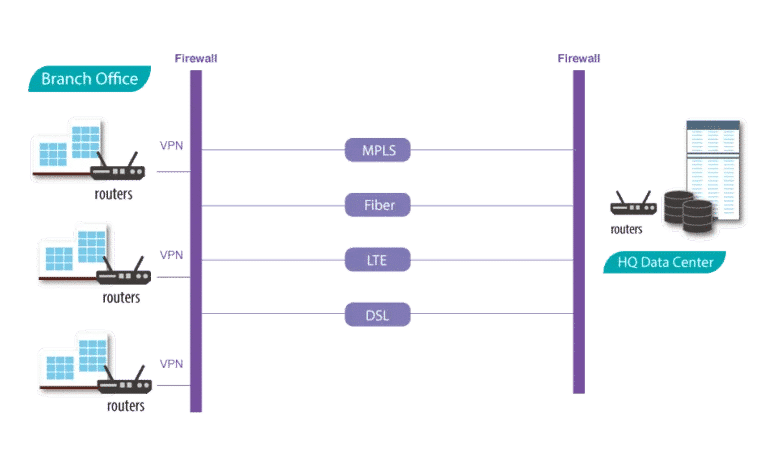
When network technology goes to software, here comes SDN, software-defined networking, which separates the data and control planes to make the task of network administration become much more dynamic and flexible. SD-WAN is a software-based approach to wide area networks — a virtual WAN based on SDN technology. It can be used to connect any application across multiple network types, such as MPLS, 4G, 5G, and broadband internet. Via a central SD-WAN controller and its user-friendly interface, where users can set up the connectivity application and define security policies across all available network connections at every site.
Nowadays, enterprises face two major challenges in IT-related applications. One is the low tolerance for latency which requires extremely high performance, and the other is processing the huge number of data. These requirements make traditional WAN that transmits data and transactions through data centers more difficult. SaaS, other cloud services, and more mobile devices also make traditional routers overburdened.


With SD-WAN, its huge advantages include enhanced global availability, visibility, scalability, easy control, and performance. It can not only directly connect branches through the public Internet, but also securely connect cloud applications and services. When necessary, it can also support a secure connection via MPLS back to the core data center.

By transferring traffic from MPLS connections to broadband Internet and LTE/ 5G links, SD-WAN works through software to control all the network; it’s easier to maintain and lower down the operational cost.

SD-WAN can not only protect data during transfer from end to end but also control and monitor the flow of the internet, avoiding internet crash.

As more and more Enterprises use SaaS services such as Salesforce and Office 365, SD-WAN can provide high quality and low rescue connection to SaaS/Cloud environment.

As SD-WAN represents software define networking, it has its own software interface to monitor and manage the operation status of the entire networking.

With SD-WAN, it can provide the internet much easier to control, monitor, switch between several routes or share the bandwidth to make sure the quality of connection.

SD-WAN has a software interface. Once any issue occurs, the controller can find out the issue at the first moment, and helps reduce the time to detect the issue and also the cost for maintenance.
5G will be the major wireless WAN option, and we believe that this transition will be a key driver for SD-WAN adoption. Having at least 10 times faster than 4G with lower latency, and the most advanced encryption technology and authentication features. These advantages of 5G lead itself as a prime choice for wireless SD-WAN use cases.
For the system design, we need to consider at least 6 antenna holes to support WiFi and 3G/4G/5G Networks; especially, the Gen 5th mobile network includes sub-6GHz and mmWave bands.
In recent years, more and more objects will be connected to the cloud through the Internet, forming the so-called “Internet of Things”. Due to the rapid expansion of IoT devices and computing at the edge, billions of IoT devices are in the mesh edge environment and connected to each other; any device may become the weakest link out of security concern. Enterprises now face the challenges of how to effectively manage these end devices, remote deployment, and control security. So, to deal with this challenge, there will be some fundamental changes in the structure and management of the network.
The new standard 802.11ax was named WiFi 6. The birth of Wi-Fi 6 will make wireless high-frequency transmission more efficient; in addition, because Wi-Fi 6 is a regional network, it can coexist with 5G wireless networks.
With the advent of the new Wi-Fi 6 standard, which combines two frequency bands, 2.4GHz, 5GHZ, it also incorporates features such as wide reception range and high network speed, which can meet our needs for high-speed networks at one time.
Due to the characteristics of long-distance Internet of Things, Low Power Wide Area Network (LPWAN) technology has emerged. In the case of only providing batteries, a huge number of devices can continuously transmit a key small amount of data to the monitoring center over a long distance, and under the analysis of Big Data and Artificial Intelligence (AI), the traffic monitoring, real-time updating, emergency processing and other quality optimizing can be achieved. These non-traditional connectivity options will also be a factor for the emerging use of wireless SD-WAN.
To provide the best experiences, we and our partners use technologies like cookies to store and/or access device information. Consenting to these technologies will allow us and our partners to process personal data such as browsing behavior or unique IDs on this site and show (non-) personalized ads. Not consenting or withdrawing consent, may adversely affect certain features and functions.
Click below to consent to the above or make granular choices. Your choices will be applied to this site only. You can change your settings at any time, including withdrawing your consent, by using the toggles on the Cookie Policy, or by clicking on the manage consent button at the bottom of the screen.